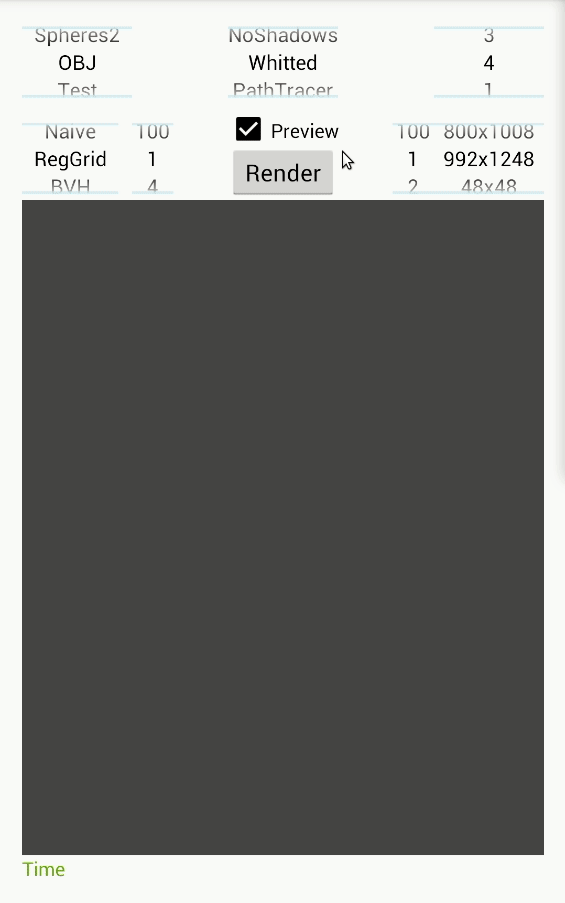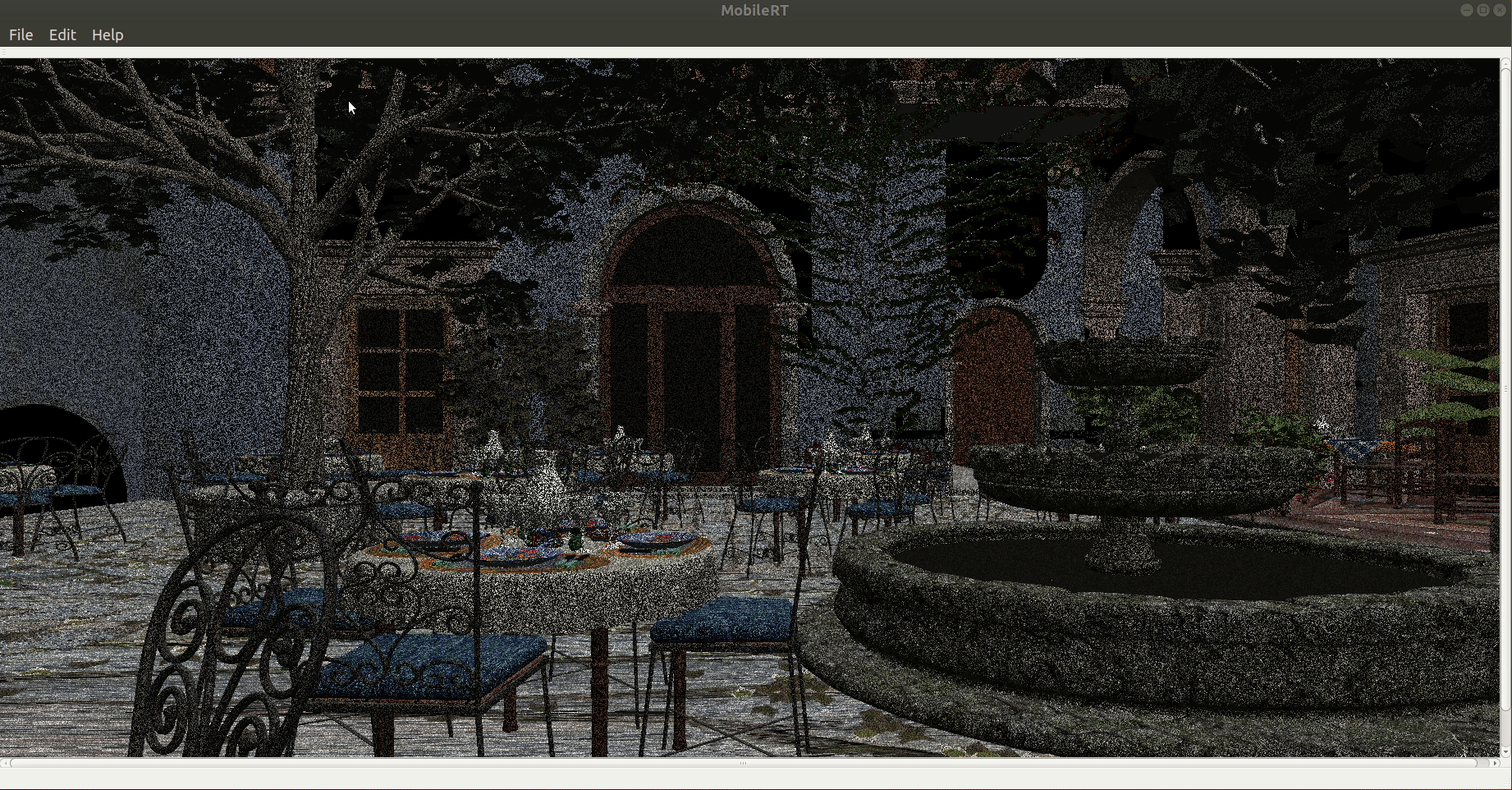MobileRT
MobileRT - A multi platform C++ CPU progressive Ray Tracer.
Project maintained by TiagoMSSantos Hosted on GitHub Pages — Theme by mattgraham
MobileRT: Mobile Ray Tracing engine
- A portable Ray Tracing (RT) engine for multiple devices.
- Already available interfaces for:
- Android (through Java + JNI and C)
- Linux, MacOS, Windows (through Qt 5 or 6)
- Compatible with C++ compilers:
- GNU C++ Compiler (g++)
- Clang++
- MinGW (g++)
- Microsoft Visual C++ (MSVC)
- Intel® oneAPI DPC++/C++ Compiler (ICX)


Run docker image
This C++ Ray Tracer is compatible with Android and Linux.
For Linux, if docker is installed, it is possible to try this ray tracer with ease by using the following commands to get the docker image and execute the container:
docker pull ptpuscas/mobile_rt:ubuntu-24.04;
xhost +; docker run -it -v /tmp/.X11-unix:/tmp/.X11-unix -e DISPLAY=${DISPLAY} ptpuscas/mobile_rt:ubuntu-24.04;
or (still WIP)
xhost +; docker-compose -f deploy/docker-compose.yml up MobileRT;
And a docker container should start and render the conference room model like the image above :)
Build docker image
For the most curious, this is the command used to build the docker image:
docker build -t ptpuscas/mobile_rt:ubuntu-24.04 -f deploy/Dockerfile.unix --no-cache=false --build-arg BUILD_TYPE=release --build-arg BASE_IMAGE=ubuntu:24.04 .;
The docker image is in docker hub: https://hub.docker.com/r/ptpuscas/mobile_rt.
Compile Ray tracer
It is also possible to clone this repository and compile this ray tracer by yourself. To compile it, it is essential to install cmake and have a C++20 compiler. It is also needed the Qt5 or Qt6 library and the git control system to get the code from the repository.
sh scripts/install_dependencies.sh;
Then, to finally compile this code for the native machine, just execute the following command:
sh scripts/compile_native.sh -c g++ -t release -r yes;
Run Ray tracer
This ray tracer comes with a script with many functionalities useful to run
static code analyzers and to benchmark the ray tracer itself.
To execute the ray tracer just use the profile.sh shell script available in the
scripts directory.
The following command should start the ray tracer when executed in the root directory:
sh scripts/profile.sh release;
Android
To try this ray tracer for Android just download the APK file available in the repository.
Or you can compile yourself for Android as well. First, install all the necessary dependencies:
sh scripts/install_dependencies.sh;
sh gradlew build -DandroidApiVersion='<android_api>' -DabiFilters='["<cpu_architecture>"]' --dry-run -Dorg.gradle.configuration-cache=true --parallel --info --warning-mode all --stacktrace;
Then, to finally compile this code for Android, execute the following command:
sh scripts/compile_android.sh -c g++ -t release -r yes -a <android_api> -f \"<cpu_architecture>\";
Models Wavefront OBJ
To get some OBJ models, just download some from here: OBJs. Then, it will just be needed to add some lights in the scene geometry, by using some modeling application like 3D Blender. One thing to have it in account is to make sure the light material has the light emission component (Ke) with some positive values in the ".mtl" file. Finally, add a camera file with the extension ".cam" that should contain a definition of a perspective camera, like for example:
t perspective #type of the camera
p 0 0 0 #position of the camera x y z
l 0 0 1 #look at of the camera x y z
u 0 1 0 #up vector of the camera x y z
f 45 45 #field of view of the camera u v
Third party frameworks / libraries used
- [x] C++ Boost libraries for the assertions
- [x] C++ OpenGL Mathematics library to help in the vector math
- [x] C++ tinyobjloader library to load Wavefront OBJ model files
- [x] C++ Qt5 or Qt6 framework for Linux interface
- [x] C++ Google Test framework for unit tests
- [x] C STB libraries library to load the textures
- [x] Java Streams to reduce complexity
- [x] Java Google Guava framework to reduce complexity
- [x] Java JUnit4 framework for unit tests
- [x] Java AssertJ library for unit tests assertions
- [x] Java Android Espresso library for instrumented tests
- [x] Java EasyMock framework for mocking in unit tests
- [x] Java PowerMock for EasyMock
framework to improve mocking in unit tests since it allows mocking
finalclasses,nativeandstaticmethods.
Supported Operating Systems
| OS | Versions | ||||
|---|---|---|---|---|---|
| Android | 4.0.3 (API 15) |
4.4 (API 19) |
4.4W (API 20) |
5.0 (API 21) |
16 (API 36) |
| MacOS | 11 |
12 |
13 |
14 |
15 |
| Windows | Server 2019 |
Server 2022 |
Server 2025 |
10 |
11 |
| Ubuntu | 16.04 |
18.04 |
20.04 |
22.04 |
24.04 |
| CentOS | 5 |
6 |
7 |
8 |
stream |
| Alpine | 3.18 |
3.19 |
3.20 |
3.21 |
3.22 |
| Arch Linux | base-devel |
||||
| Gentoo | stage3:x86 |
||||
Requirements
It's necessary the following SDKs in order to compile this project for Android:
- Android SDK which should also bring the Android NDK in order to compile the native code.
For native Linux, MacOS and Windows support, the install_dependencies.sh script should download and install the necessary dependencies, by just calling:
sh scripts/install_dependencies.sh;
Note that the script already supports multiple Linux distributions like:
- Debian (using apt)
- Red Hat (using yum)
- Arch (using pacman)
- Alpine (using apk)
- Gentoo (using emerge)
It also supports installing dependencies in the following Operating Systems:
- MacOS (using Homebrew)
- Windows (using Chocolatey)
Note that these scripts are tested in Github actions pipeline only, so it might assume that some tools are already installed in the system. If the OS you use is not supported, or it's missing the installation of some tool, you can always open an issue or even a pull request.
Documentation
Click here to check the features list that are supported.
Click here to check the code coverage and code duplication commands.
Click here to build and serve the documentation locally.
Click here for some basic Blender tips.
Click here to check the Doxygen codebase documentation.

